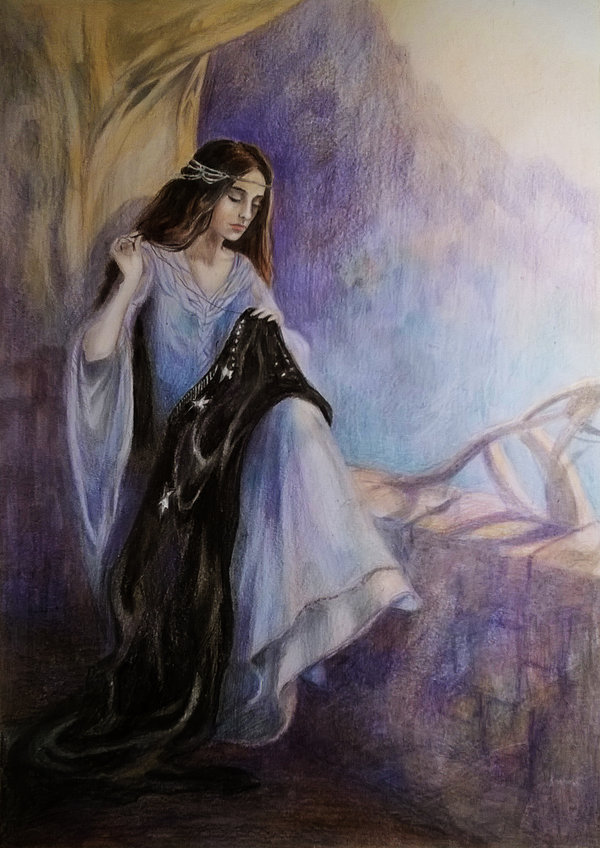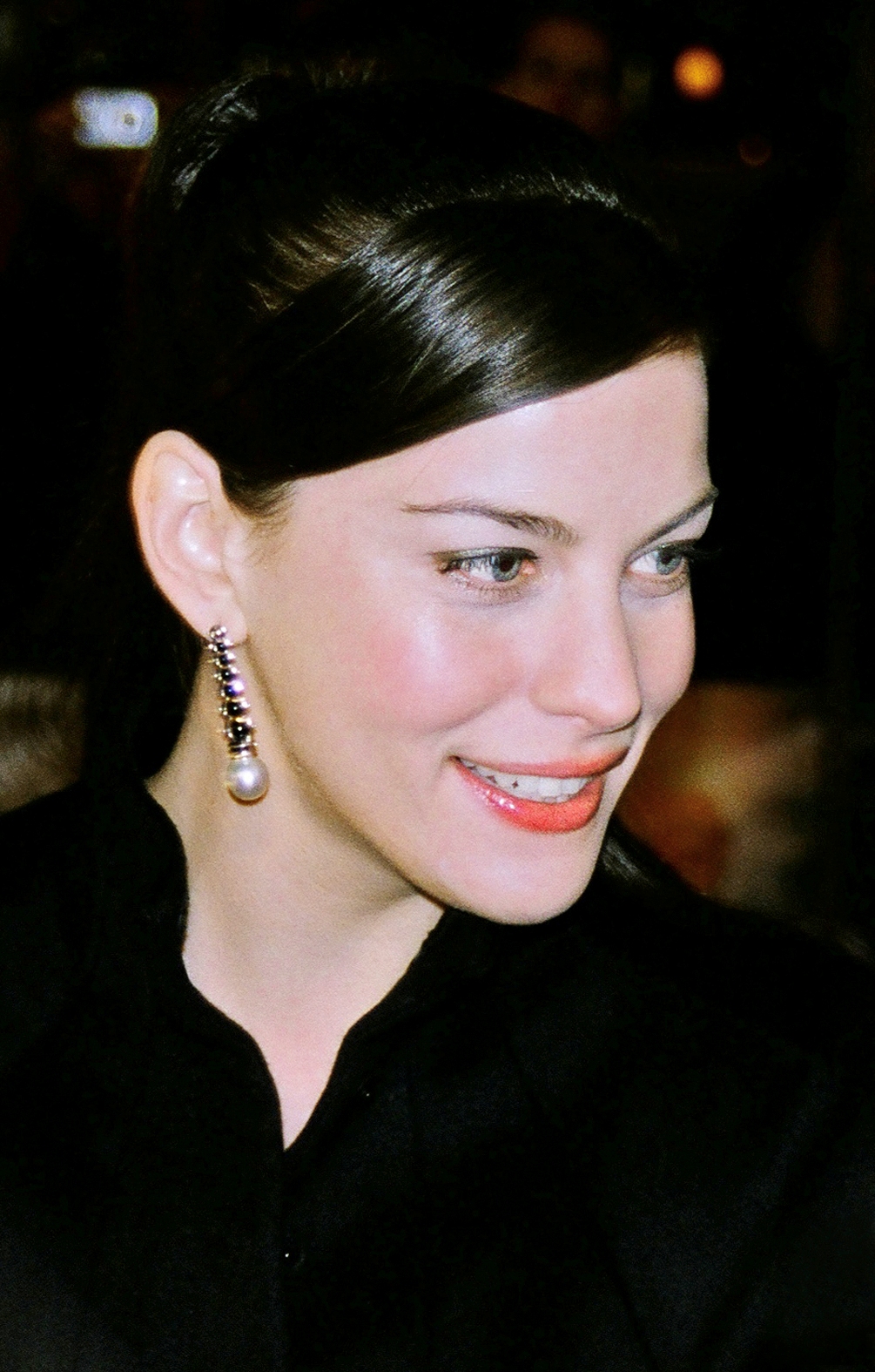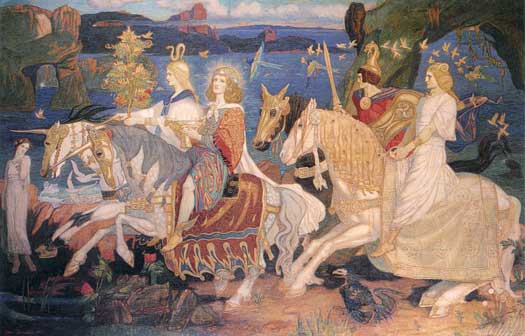1. Background and Genealogy
Arwen Undómiel's background is deeply rooted in the ancient history and complex genealogies of Middle-earth, connecting her to the most prominent houses of Elves and Men, as well as to the Maiar.
1.1. Birth and Family
Arwen was born in the year 241 of the Third Age. She was the youngest child and only daughter of Elrond, the venerable Lord of Rivendell and a leader among the High Elves remaining in Middle-earth. Her mother was Celebrían, the daughter of Galadriel, the powerful Elf-queen and ruler of Lothlórien, and Celeborn. Arwen had two elder brothers, the twins Elladan and Elrohir.
1.2. Names and Titles
Her name, Arwen, means 'noble maiden' in Sindarin, one of the Elvish languages. She was also known by the name Undómiel (Undómielqya), which means 'Evenstar' or 'Evening Star' in Quenya. This epithet was bestowed upon her because she was considered the most beautiful of the last generation of High Elves in Middle-earth. She was widely regarded as the most beautiful being of the Third Age, possessing clear, flawless skin, long, dark hair, and grey eyes that resembled the clear evening sky. Her beauty was often compared to that of her ancestor, Lúthien Tinúviel, the fairest of all Elves, to the extent that Arwen was seen as Lúthien's reappearance.
1.3. Complex Lineage
Arwen's lineage is exceptionally complex and significant within Tolkien's legendarium, intertwining the bloodlines of Elves, Men, and Maiar.
Through her father, Elrond, Arwen was the granddaughter of Eärendil the Mariner, who was the second of the Half-elven to choose his fate. She was also the great-granddaughter of Tuor of Gondolin and a direct descendant of the Mannish House of Hador. Furthermore, through her great-grandmother, Idril Celebrindal, Arwen was a descendant of King Turgon of the Noldor.
Through her mother, Celebrían, Arwen was the granddaughter of the Elf-queen Galadriel of Lothlórien and Celeborn. This connection linked her to the royal house of Finwë of the Noldor and the Teleri of Aman.
Through both of her parents, Arwen was a direct descendant of the ancient Elven House of Finwë. Moreover, she carried the blood of the Maiar through her great-great-great grandmother, Melian, Queen of Doriath. Arwen was also a direct descendant of Beren and Lúthien, whose epic love story bore a striking resemblance to her own. This made her a distant relative of her future husband, Aragorn, as his ancestor, Elros Tar-Minyatur (the first King of Númenor), was her father Elrond's brother, who chose to live as a Man.
Her marriage to Aragorn served to reunite the long-separated lines of the Half-elven, bringing together the descendants of Elrond and Elros. This union also symbolically united and preserved the bloodlines of the three kings of the High Elves (Ingwë, Finwë, and the brothers Olwë and Elwë), as well as the unique line with Maiarin blood, within the lineage of Men. This noble ancestry underscored Aragorn's suitability as her consort and the rightful King of the Reunited Kingdom.
1.4. Childhood and Upbringing
Arwen spent a significant portion of her early life in Lothlórien, under the care and tutelage of her grandmother, Galadriel. She also resided in Rivendell, her father Elrond's sanctuary, where she was raised. Her upbringing in these ancient Elven realms contributed to her wisdom, grace, and profound connection to the Elvish way of life, even as her destiny would lead her to choose a mortal path.
2. Major Activities and Achievements
Arwen's life was defined by her profound love for Aragorn and the monumental choice she made to forsake her immortality, a decision that had far-reaching implications for both her personal destiny and the future of Middle-earth.
2.1. Meeting Aragorn and Their Love

Aragorn first met Arwen in Rivendell when he was twenty years old and living under Elrond's protection. At this time, Arwen, already over 2,700 years old, had recently returned to her father's home after a long period residing with her grandmother, Galadriel, in Lothlórien. Aragorn was instantly captivated by her beauty, mistaking her for Lúthien Tinúviel, an ancient Elven princess of unparalleled beauty. He fell in love with her at first sight.
Thirty years later, they were reunited in Lothlórien. Arwen reciprocated Aragorn's love, and on the green mound of Cerin Amroth, they pledged their commitment to marry each other. This betrothal marked the beginning of a love story that would shape the destiny of the Reunited Kingdom.
2.2. Renouncing Immortality and Choosing Mortal Life
In choosing to marry Aragorn, Arwen made the momentous decision to renounce her Elvish immortality. This meant she would forsake the opportunity to travel to the Undying Lands with her kin and instead embrace a mortal life in Middle-earth, sharing the fate of Men. Her father, Elrond, initially attempted to persuade her to accompany him to Valinor, as he did not wish to see any of his kin face the sorrow of mortality. However, Arwen's love for Aragorn was absolute, and she chose to remain. This choice mirrored that of her distant ancestor, Lúthien, who also chose mortality for the love of a mortal Man. Arwen would later come to truly understand the profound sorrow of human death only after Aragorn's passing.
2.3. Role in the War of the Ring
Arwen's direct involvement in the events of The Lord of the Rings is limited, yet her influence on Aragorn and the broader narrative is significant. She first appears in the main text of The Lord of the Rings in Rivendell, attending a celebratory feast shortly after Frodo Baggins awakens in the House of Elrond. Later, when the Fellowship of the Ring passes through Lothlórien, Aragorn pauses in reverence, remembering his earlier meeting with Arwen there.
Her most notable direct action in the lead-up to the war was the creation of a banner for Aragorn. Shortly before Aragorn embarked on the perilous Paths of the Dead, he was joined by his people, accompanied by Arwen's brothers, Elladan and Elrohir. They brought him a gift from Arwen: a banner of black cloth. This banner was dramatically unfurled at the Battle of the Pelennor Fields, revealing the emblem of Elendil intricately figured in mithril, gems, and gold. Its appearance served as the first triumphant public announcement of the king's return, inspiring hope and courage among the forces of Gondor.
2.4. Life as Queen
After the destruction of the One Ring and the defeat of Sauron, Aragorn was crowned King of Arnor and Gondor, establishing the Reunited Kingdom. Arwen arrived at Minas Tirith, and they were married in a grand ceremony. As his wife, she became the Queen of the Reunited Kingdom. Together, they had a son, Eldarion, who would succeed Aragorn as king, and at least two unnamed daughters. Arwen also gave Frodo Baggins her Evenstar necklace, a white gem on a silver chain, as a token of aid for him when his injuries troubled him. Her reign as Queen marked the beginning of a new era for Men in Middle-earth, uniting the ancient bloodlines of Elves and Men.
2.5. Death
Arwen's mortal life, though long by human standards, was fleeting compared to her Elvish past. In the year 120 of the Fourth Age, after a reign of 120 years, Aragorn sensed his old age and the growth of their son, Eldarion, and chose to pass from the world at the age of 210 years. Arwen, though she tried to dissuade him, was overcome with profound sorrow, as she had not truly comprehended the nature of human death until that moment.
Her joy departed, and she decided to leave the world as well. One year after Aragorn's death, in the year 121, Arwen journeyed to Lothlórien, which had become desolate after the departure of its Elven inhabitants. She lay down on the mound of Cerin Amroth, the very place where she and Aragorn had pledged their love, and there she died, at the age of 2,901 years. Her passing symbolized the definitive end of the Elvish era in Middle-earth; after her death, the Niphredil and Elanor flowers, which were associated with Lúthien and the Elves, ceased to bloom east of the sea, signifying the close of the age of myth.
3. Status and Analysis in the Work
Arwen's character, though not always central to the action, holds deep symbolic meaning and plays a crucial role in the thematic underpinnings of The Lord of the Rings.
3.1. Symbolism
Arwen is a powerful symbol within Tolkien's narrative. She represents hope, sacrifice, and enduring love. Her decision to renounce immortality for Aragorn's sake is a profound act of self-sacrifice, embodying a love so strong it transcends the boundaries of race and destiny. Her beauty, often described as unparalleled, makes her a symbol of the unattainable, particularly in Éowyn's eyes concerning Aragorn. Arwen also symbolizes the "twilight of the Elven era," as her choice to become mortal signifies the fading of the Elves from Middle-earth and the rise of Men. Her voluntary choice of mortality, out of love, has been compared by scholars to Christ's voluntary sacrifice, highlighting the depth of her commitment. Despite not engaging in battles like Éowyn, her inner strength and resolve are subtly but consistently conveyed throughout the novel, acting as a constant, underlying power.
3.2. Comparison with Lúthien
Arwen is frequently compared to her distant ancestor, Lúthien Tinúviel, the Elf-maiden of the First Age. This comparison is explicit in the text, with Arwen often described as Lúthien's likeness or even her reappearance. Both Lúthien and Arwen, referred to as the "Morning Star" and "Evening Star" of the Elves respectively, brought both great joy and sorrow to Middle-earth through their choices. Crucially, both chose to forsake their immortality for the love of a mortal Man. This parallel underscores a central theme of Tolkien's legendarium: the intertwining destinies of Elves and Men. The fact that the Niphredil flowers (which first bloomed when Lúthien was born) and Elanor flowers (brought by Elves to Númenor) ceased to bloom after Arwen's death further emphasizes her connection to Lúthien and the symbolic end of the Elvish age.
3.3. Role as a Female Character
Arwen's role as a female character has been a subject of critical discussion. Tolkien conceived of "Elrond's daughter" relatively late in the writing process, having initially considered Aragorn marrying Éowyn of Rohan. Her limited direct involvement in the main narrative, particularly her lack of participation in battles, aligns with the general pattern of Elves retreating to safe havens in Tolkien's works.
However, her significance is profound. Arwen serves as a crucial inspiration and motivation for Aragorn, driving him to fulfill his destiny as King of the Reunited Kingdom. Her unwavering fidelity to Aragorn also plays a role in Éowyn's character arc, as Aragorn's inability to return Éowyn's affections leads Éowyn to pursue heroic deeds on the battlefield, ultimately slaying the Witch-king of Angmar.
Tolkien's writings, particularly in Morgoth's Ring, suggest that male and female Elves were considered equal in their society. While Elven women were trained in combat, they typically did not go to war, often serving as healers, as their capacity for childbearing was seen as holding the future of their people. This perspective frames Arwen's agency not through physical combat, but through her profound personal choices and the impact of her love and sacrifice on the future of Middle-earth.
4. Adaptations
Arwen's portrayal has varied across different adaptations of The Lord of the Rings, with some interpretations expanding her role significantly beyond the original text.
4.1. Peter Jackson's Film Series

In Peter Jackson's The Lord of the Rings film trilogy, Arwen is played by Liv Tyler. The films give her a more prominent and active role compared to her literary counterpart, often incorporating elements from the appendices or creating entirely new scenes.
Key differences from the book include:
- Rescue of Frodo:** In The Fellowship of the Ring, Arwen single-handedly rescues Frodo Baggins from the Black Riders at the Fords of Bruinen, summoning a sudden flood to thwart them. In the book, this role was performed by Glorfindel, and the flood was summoned by Elrond and Gandalf. During this flight, Arwen wields the sword Hadhafang, which, according to film merchandise, belonged to her great-grandmother, Idril Celebrindal.
- Visions and Dying:** In The Two Towers, an injured Aragorn is revived by a dream or vision of Arwen. The films also introduce a plotline where Arwen's fate becomes bound to the One Ring, and she is shown to be dying as Sauron's power grows. Sauron even uses a Palantír to show Aragorn a vision of a dying Arwen to weaken his resolve.
- Refusal to Depart:** In the extended version, Elrond asks Arwen to accompany him to safety in Valinor. However, Arwen sees a vision of her future son, Eldarion, and decides to return to Rivendell, refusing to leave Middle-earth due to her love for Aragorn. She then persuades Elrond to reforge Narsil into Andúril, which Elrond personally delivers to Aragorn.
- Evenstar Pendant:** The films introduce a jeweled pendant called the Evenstar, which Arwen gives to Aragorn as a token of their love. In Tolkien's novel, Arwen gives Frodo a similar "white gem like a star" before he leaves Minas Tirith.

Liv Tyler's performance and these expanded scenes generated discussion among fans and critics. While some appreciated Arwen's increased visibility and agency, others argued it deviated from Tolkien's original intent, particularly regarding her warrior portrayal. Early script versions included Arwen fighting in the Battle of Helm's Deep and bringing Andúril to Aragorn, but these scenes were filmed and later cut, with Liv Tyler's approval, to maintain thematic consistency and emphasize Éowyn's role as a warrior. Despite the changes, some scholars argue that the film's portrayal of Arwen remains thematically faithful to or compatible with Tolkien's writings, especially in emphasizing her choice of mortality for love, mirroring Lúthien.
4.2. Other Media
Arwen has been depicted in various other adaptations of The Lord of the Rings:
- She does not appear in Ralph Bakshi's 1978 animated film adaptation of The Lord of the Rings or the 1980 Rankin-Bass adaptation of The Return of the King.
- In the 1981 BBC radio serialisation of The Lord of the Rings, Arwen was voiced by Sonia Fraser.
- In the musical theatre adaptation of Lord of the Rings, Arwen was played by Rosalie Craig in London in 2007. She sings the Prologue and several musical numbers, including "The Song of Hope" and "Star of Eärendil".
- In the 2009 fan film The Hunt for Gollum, Arwen was played by Rita Ramnani.
- A rendition of Arwen by conceptual designer John Howe, inspired by the French actress Isabelle Adjani, was used in The Lord of the Rings board game.
- Arwen also appears in various video games based on the franchise.
5. Family Tree
Arwen's intricate lineage connects her to the most ancient and noble houses of Elves and Men, as well as to the Maiar. This table illustrates her key ancestors and their relationships, highlighting the convergence of these significant bloodlines.
| Relationship | Name | Race / Origin | Notes |
|---|---|---|---|
| Parents | Elrond and Celebrían | Half-elven and Elf | Elrond is a Half-elven, Celebrian is an Elf. |
| Paternal Grandparents | Eärendil and Elwing | Half-elven | Eärendil was the first Half-elven to choose his fate. |
| Maternal Grandparents | Galadriel and Celeborn | Elf | Galadriel is of the Noldor, Celeborn is a Sindar Elf. |
| Paternal Great-Grandparents | Tuor and Idril Celebrindal | Man and Elf | Tuor was a Man of the House of Hador. Idril was a Noldorin Elf, daughter of King Turgon. |
| Maternal Great-Grandparents | Finarfin and Eärwen | Elf | Finarfin was a Noldorin Elf-lord, Eärwen was a Teleri Elf. |
| Paternal Great-Great-Grandparents | Huor and Rían | Man | Huor was of the House of Hador. |
| Paternal Great-Great-Grandparents | Turgon and Elenwë | Elf | Turgon was a Noldorin Elf-king, Elenwë was a Vanyarin Elf. |
| Paternal Great-Great-Great-Grandparents | Beren and Lúthien Tinúviel | Man and Half-elven | Lúthien was the daughter of Thingol and Melian, the first Half-elven. |
| Paternal Great-Great-Great-Grandparents | Húrin and Morwen | Man | Húrin was of the House of Hador. |
| Paternal Great-Great-Great-Grandparents | Fingolfin and Anairë | Elf | Fingolfin was a Noldorin Elf-king. |
| Paternal Great-Great-Great-Great-Grandparents | Thingol and Melian | Elf and Maia | Thingol was a Sindar Elf-king, Melian was a Maia. |
| Paternal Great-Great-Great-Great-Grandparents | Finwë and Indis | Elf | Finwë was the first High King of the Noldor, Indis was a Vanyarin Elf. |
Arwen's lineage ultimately traces back to the three great houses of Elves (Vanyar, Noldor, Teleri), the three houses of Men (Hador, Haleth, Bëor), and the divine Maiar through Melian. This convergence of bloodlines in Arwen and her subsequent marriage to Aragorn, who was descended from Elrond's brother Elros (the first King of Númenor who chose the fate of Men), symbolically reunited the divided Half-elven line and cemented the future of Middle-earth with the ascendancy of Men.